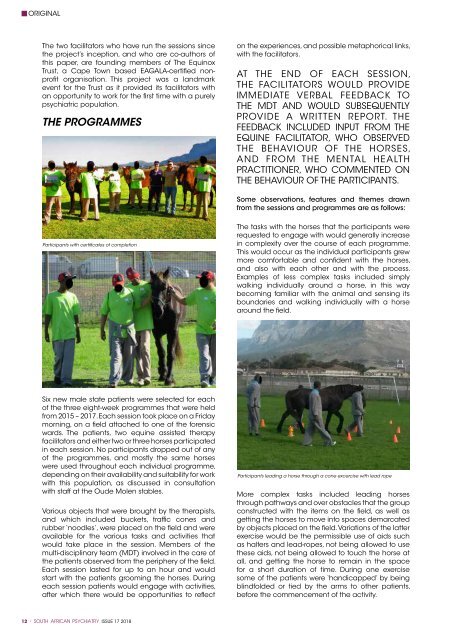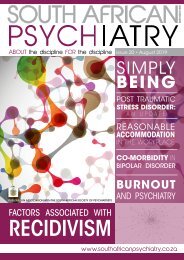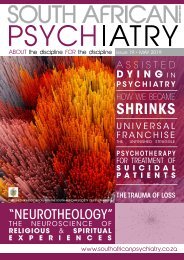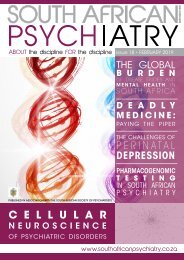South African Psychiatry - November 2018
South African Psychiatry - November 2018
South African Psychiatry - November 2018
You also want an ePaper? Increase the reach of your titles
YUMPU automatically turns print PDFs into web optimized ePapers that Google loves.
ORIGINAL<br />
The two facilitators who have run the sessions since<br />
the project’s inception, and who are co-authors of<br />
this paper, are founding members of The Equinox<br />
Trust, a Cape Town based EAGALA-certified nonprofit<br />
organisation. This project was a landmark<br />
event for the Trust as it provided its facilitators with<br />
an opportunity to work for the first time with a purely<br />
psychiatric population.<br />
THE PROGRAMMES<br />
on the experiences, and possible metaphorical links,<br />
with the facilitators.<br />
AT THE END OF EACH SESSION,<br />
THE FACILITATORS WOULD PROVIDE<br />
IMMEDIATE VERBAL FEEDBACK TO<br />
THE MDT AND WOULD SUBSEQUENTLY<br />
PROVIDE A WRITTEN REPORT. THE<br />
FEEDBACK INCLUDED INPUT FROM THE<br />
EQUINE FACILITATOR, WHO OBSERVED<br />
THE BEHAVIOUR OF THE HORSES,<br />
AND FROM THE MENTAL HEALTH<br />
PRACTITIONER, WHO COMMENTED ON<br />
THE BEHAVIOUR OF THE PARTICIPANTS.<br />
Some observations, features and themes drawn<br />
from the sessions and programmes are as follows:<br />
Participants with certificates of completion<br />
The tasks with the horses that the participants were<br />
requested to engage with would generally increase<br />
in complexity over the course of each programme.<br />
This would occur as the individual participants grew<br />
more comfortable and confident with the horses,<br />
and also with each other and with the process.<br />
Examples of less complex tasks included simply<br />
walking individually around a horse, in this way<br />
becoming familiar with the animal and sensing its<br />
boundaries and walking individually with a horse<br />
around the field.<br />
Six new male state patients were selected for each<br />
of the three eight-week programmes that were held<br />
from 2015 – 2017. Each session took place on a Friday<br />
morning, on a field attached to one of the forensic<br />
wards. The patients, two equine assisted therapy<br />
facilitators and either two or three horses participated<br />
in each session. No participants dropped out of any<br />
of the programmes, and mostly the same horses<br />
were used throughout each individual programme,<br />
depending on their availability and suitability for work<br />
with this population, as discussed in consultation<br />
with staff at the Oude Molen stables.<br />
Various objects that were brought by the therapists,<br />
and which included buckets, traffic cones and<br />
rubber ‘noodles’, were placed on the field and were<br />
available for the various tasks and activities that<br />
would take place in the session. Members of the<br />
multi-disciplinary team (MDT) involved in the care of<br />
the patients observed from the periphery of the field.<br />
Each session lasted for up to an hour and would<br />
start with the patients grooming the horses. During<br />
each session patients would engage with activities,<br />
after which there would be opportunities to reflect<br />
Participants leading a horse through a cone excercise with lead rope<br />
More complex tasks included leading horses<br />
through pathways and over obstacles that the group<br />
constructed with the items on the field, as well as<br />
getting the horses to move into spaces demarcated<br />
by objects placed on the field. Variations of the latter<br />
exercise would be the permissible use of aids such<br />
as halters and lead-ropes, not being allowed to use<br />
these aids, not being allowed to touch the horse at<br />
all, and getting the horse to remain in the space<br />
for a short duration of time. During one exercise<br />
some of the patients were ‘handicapped’ by being<br />
blindfolded or tied by the arms to other patients,<br />
before the commencement of the activity.<br />
12 * SOUTH AFRICAN PSYCHIATRY ISSUE 17 <strong>2018</strong>

















